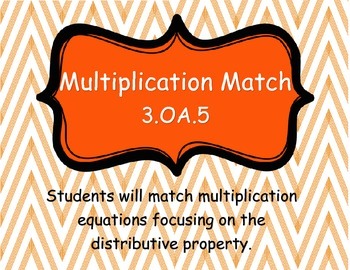Multiplication Match (Distributive Property) ~ 3.OA.5
Learning with Leah
159 Followers
Grade Levels
3rd - 6th
Subjects
Resource Type
Standards
CCSS3.OA.B.5
Formats Included
- Zip
Pages
16 pages
Learning with Leah
159 Followers
What educators are saying
This is a great resource for this standard! Students really struggle with this skill, and I love how they can match the distributive property to the original problem!
Description
This product features 26 sets of matching cards that can be used in numerous ways. One card features an 'original' multiplication equation, and it's match demonstrates a distributive equation.
Common Core Standard 3.OA.5
Florida Math Standard MAFS.3.OA.2.5 lv.2
Please view the preview for just a few suggestions as how you can use the cards with your students!
I worked hard to offer you an original product. Your purchase allows use in ONE classroom. Additional license available at a discounted price. Please do not post any portions of the game online. Thank you for being respectful!
****************************************************************************
Follow me to be sure to be that you are notified of my sales and flash freebies!
Up to the minute product announcements, flash freebies, and sale alerts! Learning with Leah on Facebook
Common Core Standard 3.OA.5
Florida Math Standard MAFS.3.OA.2.5 lv.2
Please view the preview for just a few suggestions as how you can use the cards with your students!
I worked hard to offer you an original product. Your purchase allows use in ONE classroom. Additional license available at a discounted price. Please do not post any portions of the game online. Thank you for being respectful!
****************************************************************************
Follow me to be sure to be that you are notified of my sales and flash freebies!
Up to the minute product announcements, flash freebies, and sale alerts! Learning with Leah on Facebook
Total Pages
16 pages
Answer Key
Included
Teaching Duration
N/A
Report this resource to TPT
Reported resources will be reviewed by our team. Report this resource to let us know if this resource violates TPT’s content guidelines.
Standards
to see state-specific standards (only available in the US).
CCSS3.OA.B.5
Apply properties of operations as strategies to multiply and divide. Examples: If 6 × 4 = 24 is known, then 4 × 6 = 24 is also known. (Commutative property of multiplication.) 3 × 5 × 2 can be found by 3 × 5 = 15, then 15 × 2 = 30, or by 5 × 2 = 10, then 3 × 10 = 30. (Associative property of multiplication.) Knowing that 8 × 5 = 40 and 8 × 2 = 16, one can find 8 × 7 as 8 × (5 + 2) = (8 × 5) + (8 × 2) = 40 + 16 = 56. (Distributive property.)





